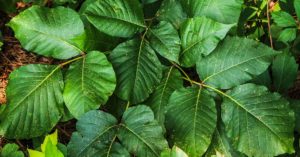 Indigo Urgent Care reports an estimated 85% of Americans, many of them hunters, fishers and hikers like us, are allergic to poison ivy and/or oak.
Indigo Urgent Care reports an estimated 85% of Americans, many of them hunters, fishers and hikers like us, are allergic to poison ivy and/or oak.
You know a bad case of the rash can put a damper on summertime, but don’t let your guard down in the fall.
I’m one of the 85%, and the worst case of poison ivy I ever got was during bow season one October. My climbing stand cut a vine that I stupidly did not see as I worked my way up a tree. Bits of vine hairs and bark and sap slid down my neck and around the sides of my head. My head swelled and a horrendous bubble of blisters broke out around neck and ears.
Pure agony! I had to go to a clinic for treatment.
So continue to look for and avoid the poison plants when you hit the deer woods in a few weeks.
Poison Ivy or Poison Oak?
Poison ivy and oak plants share many similarities. Some common characteristics include:
- Growing as a vine or bush
- No thorns present
- Varying sizes of leaves
- Clusters of three leaves
- Having white spring flowers and red berries
While these plants are similar looking, there are a few ways to tell them apart.
Poison ivy generally has hairy- or fuzzy-looking vines, looks similar to ivy and has smooth, almond-shaped leaves.
Poison oak, on the other hand, has leaves that look like oak leaves, is generally a duller green and has leaflets that have hair on both sides.
These plants can be pretty difficult to tell apart not only from each other but from other plants as well.
That’s why it’s so important to protect your skin when you’re in wooded areas. Wearing long clothing can be a simple and easy way to keep your skin protected from brushing up against these rash-inducing plants.
Treating Poison Ivy and Poison Oak
If you do come into contact with poison ivy or oak, rinse the affected area with cool water. While the rash caused by these plants can be uncomfortable, it’s generally not severely harmful. Rashes from these plants generally show up within no more than 48 hours after the contact. Common signs include red, itchy bumps.
One of the most common poison ivy and poison oak rash home remedies involves calming the rash by using cool compresses, antihistamines and calamine lotion.
But if the rash persists or becomes severely uncomfortable, you should seek medical care. Consider a trip to an urgent care clinic if the rash is accompanied by significant swelling, a fever, blisters or difficulty breathing.






The best remedy I have found for poison ivy is a product called ORAL IVY which is a homeopathic remedy. It is available at multiple locations nationwide and is the only thing I have used that works to help prevent and treat skin rashes from contact with these plants. It can be taken prior to contact and works like an immunization against the blistering. It also can be taken post exposure and has always controlled the rash (for me) from getting worse and oozing for days on end. I am extremely highly sensitive to the urushiol oil from poison ivy and have had to take Prednisone (which was pretty much useless) and then was tipped off to this product. Wish I had known about it years ago when I was in the Army as that is when multiple exposures during training made my tolerance go to zero.
Post penguin linkbuilding needs a knowledge of the algorithms
the best way to the rethink. Let’s suppose magazines not
have articles and are filled with print public notices?